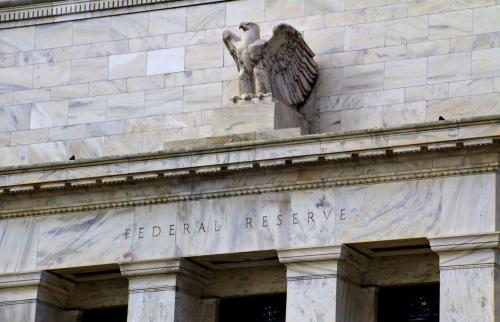The panel summarized here is part of the fall 2022 edition of the Brookings Papers on Economic Activity, the leading conference series and journal in economics for timely, cutting-edge research about real-world policy issues. The panel was held at the Fall 2022 BPEA conference. The final versions of panelist remarks were published in the Fall 2022 issue by Johns Hopkins University Press.
See the Fall 2022 BPEA event page to watch conference recordings. Submit a proposal to present at a future BPEA conference here.
Read final paper by Krishnamurthy»
Read final paper with online appendix by Ludvigson»
Read final paper by Wright» Download data/programs for Wright’s paper»
Read summary of panel discussion»
Economists Arvind Krishnamurthy, Sydney C. Ludvigson, and Jonathan H. Wright explored the lessons learned from the Federal Reserve’s use of large-scale securities purchases during a panel discussion at the Brookings Papers on Economic Activity (BPEA) conference on September 9.
In March 2020, as the COVID-19 pandemic roiled international financial markets, threatening the economy, the Federal Reserve began buying hundreds of billions of dollars of Treasury and government-backed mortgage securities.
It had first used large-scale securities purchases, known as quantitative easing, or QE, during the 2008-2009 global financial crisis. In the latest QE round, the Fed’s balance sheet more than doubled from $4.3 trillion in March 2020 to $8.9 trillion in May 2022, when it announced that it would begin to shrink its securities holdings.
Krishnamurthy, of the Stanford Graduate School of Business, explored the differences between QE and the Fed’s conventional tool for supporting economic activity—changes in its short-term interest rate target (the federal funds rate). Because of those differences, the Fed should adapt its policy rules to allow for more-targeted use of QE and more timely reductions in its balance sheet, he said.
“A wise approach is often: If it ain’t broke, don’t fix it. And so, I think, for that reason, if for no other, it’s not just likely but also, I think, wise for the Fed to keep a pretty big balance sheet.”
-Jonathan H. Wright
QE’s effects are narrower—they differ depending on which securities the Fed purchases—and its effects are greater during financial crises, Krishnamurthy explained. Nevertheless, he said, the Federal Reserve often talks about the effects of QE and conventional short-term interest rate changes in similar terms—by comparing their effects on the 10-year Treasury rate.
It is convenient to talk about QE in units of conventional policy, because it allows the Fed to communicate QE policy more easily, Krishnamurthy said, “but it is wrong.”
Tying conventional and unconventional policies together has resulted in tying the rules of entry and exit from the policies together, he said. As a result, the Fed’s exit from QE was delayed in both the recoveries from the global financial crisis and the COVID recession, he said, noting that the Fed’s continued purchases of mortgage securities during the pandemic probably fueled an undesirable housing boom.
He suggested tying the entry and exit from QE to financial conditions, in contrast with conventional short-term interest rate policy, which is tied to inflation and employment.
Ludvigson, of New York University, presented research (conducted with Francesco Bianchi of Johns Hopkins University and Sai Ma of the Federal Reserve Board) on the effect on the stock market of Fed communication about slowing the growth of (tapering) or reducing (tightening) its balance sheet.
They used a structural model to analyze the effects of 14 communication events from May 2013 to March 2019 on the S&P 500 index and infer the channels through which the effects flowed. The events included the taper tantrum of 2013, when then-Fed Chair Ben S. Bernanke first hinted that the Fed would slow its post-crisis pace of securities purchases, and Fed Chair Jerome H. Powell’s December 2018 “automatic pilot” remark that was interpreted as suggesting the Fed would reduce its balance sheet more than markets anticipated.
They found that both positive and negative surprises in Fed communication about tightening or tapering its balance sheet moved the S&P index as much as 2 percent, largely because investors and traders shifted their views about the likely return on stocks when compared with the return on risk-free Treasury securities. However, their model did not find that the communication events affected expectations for inflation and gross domestic product (GDP) growth.
“The open question that we were left with, … and perhaps for Fed to think about, is do these market jumps … have any relevance for the broader economy?” Ludvigson said.
Wright, of Johns Hopkins University, examined the liabilities the Fed uses to pay for its securities purchases, mainly bank reserves, currency (Federal Reserve notes), and reverse repos (short-term borrowing from institutional investors such as money market funds).
The Fed creates reserves by making electronic deposits in commercial banks’ accounts at the Fed. Before the 2008-2009 crisis, it controlled short-term interest rates by adjusting reserve levels. But since the crisis, the size of the Fed’s balance sheet, banks’ own preferences, and regulatory changes have required ample reserve levels.
A May 2022 projection by the Federal Reserve Bank of New York shows the balance sheet declining to $5.9 trillion in 2025 as reserves fall to about 8 percent of nominal GDP and reverse repos are eliminated. But Wright said that likely is too big a drop. When reserves last neared that level in September 2019, market turmoil threatened the Fed’s ability to control short-term interest rates. And, he said, reverse repos are an important part of the transmission of monetary policy. Thus, Wright expects the Fed’s balance sheet to decline only to about $7.5 trillion by the end of 2023 before it starts to grow again.
“My assumption is that QE will never get reversed, or even largely reversed,” Wright said.
He noted that mechanisms the Fed developed since the financial crisis for controlling short-term interest rates with ample reserves work well. Wright considered the likely effects of the limited decline in the balance sheet that he expects. He found the structure of market interest rates was likely to change only modestly, with only a limited effect on the broader economy.
“A wise approach is often: If it ain’t broke, don’t fix it. And so, I think, for that reason, if for no other, it’s not just likely but also, I think, wise for the Fed to keep a pretty big balance sheet,” he said.
Citations
Krishnamurthy, Arvind. 2022. “Lessons for Policy from Research.” Brookings Papers on Economic Activity, Fall. 233-242.
Ludvigson, Sydney C. 2022. “Market Reactions to the Federal Reserve’s Balance Sheet Normalization Plans.” Brookings Papers on Economic Activity, Fall. 243-258.
Wright, Jonathan H. 2022. “The Extent and Consequences of Federal Reserve Balance Sheet Shrinkage.” Brookings Papers on Economic Activity, Fall. 259-275.
-
Acknowledgements and disclosures
Arvind Krishnamurthy is a consultant to the Federal Reserve Bank of San Francisco. Sydney Ludvigson’s work was supported in part by the National Science Foundation (grant no. 2116641). Jonathan H. Wright is a visiting scholar at the Federal Reserve Bank of Philadelphia. Other than the aforementioned, the authors did not receive financial support from any firm or person for their papers or from any firm or person with a financial or political interest in their papers. They are not currently an officer, director, or board member
of any organization with a financial or political interest in their papers. David Skidmore authored the summary language for the panel discussion.








